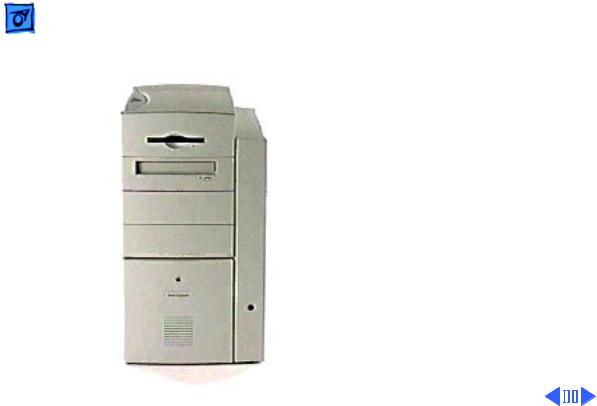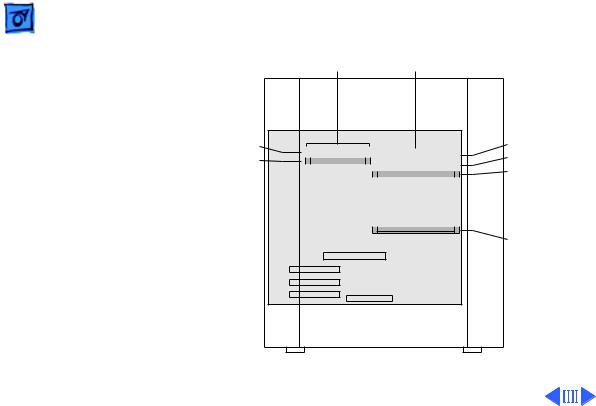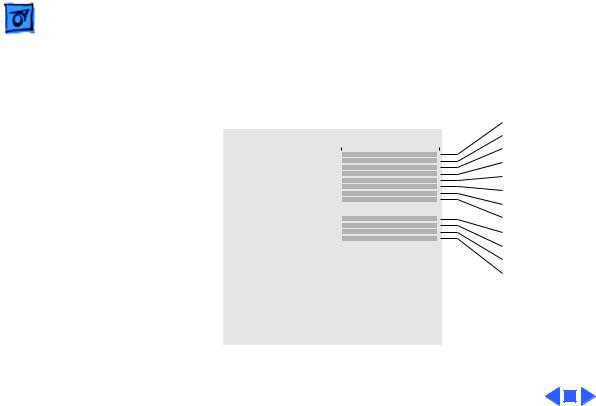Apple Mac 8600 User Manual

K Service Source
Power Macintosh 8600/
9600 & WS 9650
Power Macintosh 8600/200, 8600/250, 8600/300,
9600/200, 9600MP/200, 9600/233, 9600/300,
9600/350, WS 9650/233, and WS 9650/350

K Service Source
Basics
Power Macintosh 8600/9600 &
WS 9650

Basics |
Overview - 1 |
|
|
|
|
Overview
The Power Macintosh 8600, 9600, and Workgroup Server 9650 computers share the same housing. These systems feature a chassis design that allows you to access the logic board and its components (including the plug-in microprocessor card) simply by removing the side access panel. This flexible design makes these systems easy to service and upgrade.

Basics |
Overview - 2 |
|
|
|
|
|
Features of the Power Macintosh 8600/200 include |
|
•200 MHz PowerPC™ 604e microprocessor card with built-in FPU
•32 MB of DRAM, expandable to 512 MB using 168-pin, 70 ns, 64-bit EDO* DRAM DIMMs
•256K Level 2 cache
•2 MB VRAM, expandable to 4 MB
•2 GB hard drive
•Two SCSI DMA buses supporting up to eight SCSI devices and transfers up to 10 MB/s (internal bus only)
•Three PCI expansion slots
•24-bit video input/output support
•Built-in AAUI and 10BASE-T Ethernet
•Two GeoPort serial ports
•CD-ROM drive at 12x-speed
•Zip drive
•CD-quality stereo sound in/out

Basics |
Overview - 3 |
|
|
|
|
•Support for Open Transport networking
•Mac™ OS system software 7.5.5
Features of the Power Macintosh 8600/250 and 8600/300 include
•250 or 300 MHz PowerPC™ 604e microprocessor card with built-in FPU
•32 MB of DRAM, expandable to 512 MB using 168-pin, 70 ns, 64-bit EDO* DRAM DIMMs
•1 MB of Inline Cache
•2 MB VRAM, expandable to 4 MB
•4 GB hard drive
•Integrated Iomega Zip drive
•Two SCSI DMA buses supporting up to eight SCSI devices and transfers up to 10 MB/s (internal bus only)
•Three PCI expansion slots
•24-bit video input/output support
•Built-in AAUI and 10BASE-T Ethernet

Basics |
Overview - 4 |
|
|
|
|
•Two high-speed GeoPort serial ports
•CD-ROM drive at 24x-speed
•CD-quality stereo sound in/out
•Support for Open Transport networking
•Mac™ OS system software 7.6.1
Features of the Power Macintosh 9600/200, 9600/200MP, and 9600/233 include
•200 MHz PowerPC™ 604e processor or multiprocessor card or 233 MHz PowerPC 604e processor card with built-in FPU
•32 MB of DRAM, expandable to 768 MB using 168-pin, 70 ns, 64-bit EDO* DRAM DIMMs
•512K Level 2 cache
•4 MB VRAM on video card
•4 GB hard drive
•Two SCSI DMA buses supporting up to eight SCSI devices and transfers up to 10 MB/s (internal bus only)

Basics |
Overview - 5 |
|
|
|
|
•Six PCI expansion slots
•24-bit video input/output support
•Built-in AAUI and 10BASE-T Ethernet
•Two GeoPort serial ports
•CD-ROM drive at 12x-speed
•CD-quality stereo sound in/out
•Support for Open Transport networking
•Mac™ OS system software 7.5.5
Features of the Power Macintosh 9600/300 and 9600/350 include
•A 300 or 350 MHz PowerPC™ 604e microprocessor card with built-in FPU
•64 MB of DRAM, expandable to 768 MB using 168-pin, 70 ns, 64-bit EDO* DRAM DIMMs
•1 MB of Inline Cache
•8 MB VRAM on video card
•4 GB hard drive

Basics |
Overview - 6 |
|
|
|
|
|
• Integrated Iomega Zip drive |
|
|
• Two SCSI DMA buses supporting up to eight SCSI devices |
|
|
and transfers up to 10 MB/s (internal bus only) |
|
|
• Six PCI expansion slots |
|
|
• 24-bit video input/output support |
|
|
• Built-in AAUI and 10BASE-T Ethernet |
|
|
• Two high-speed GeoPort serial ports |
|
|
• CD-ROM drive at 24x-speed |
|
|
• CD-quality stereo sound in/out |
|
|
• Support for Open Transport networking |
|
|
• Mac™ OS system software 7.6.1 |
|
|
Features of the Workgroup Server 9650/233 and 9650/350 |
|
|
include |
|
|
• A 233 or 350 MHz PowerPC™ 604e processor card with |
|
|
built-in FPU |
|
|
• 64 MB of DRAM, expandable to 768 MB using 168-pin, |
|
|
70 ns, 64-bit EDO* DRAM DIMMs |
|

Basics |
Overview - 7 |
|||
|
|
|
||
|
• 512K or 1 MB Level 2 cache |
|||
|
• 4 MB VRAM on video card |
|||
|
• One or two 4 GB Ultra Wide hard drive(s) |
|||
|
• Three SCSI channels: one internal Ultra Wide SCSI-3 |
|||
|
(up to 40 MB/s); one internal Fast SCSI-2 (10 MB/s); |
|||
|
one external SCSI-1 (5 MB/s) |
|||
|
• Six PCI expansion slots |
|||
|
• Built-in AAUI and 10BASE-T Ethernet |
|||
|
• Two GeoPort serial ports |
|||
|
• CD-ROM drive at 12x or 24x speed |
|||
|
• CD-quality stereo sound in/out |
|||
|
• Mac™ OS system software 7.6.1 and Apple RAID 1.5 |
|||
|
*While these computers ship with EDO DIMMs, the |
|||
|
computer’s memory controller treats EDO DIMMs like fast- |
|||
|
paged DIMMs. |
|||
|
|
|
|
|
|
|
|
|
|

 Basics Configurations - 8
Basics Configurations - 8
Configurations
The Power Macintosh 8600/200 comes standard with
•200 MHz PowerPC 604e microprocessor card
•32 MB of DRAM
•2 MB of VRAM
•256K Level 2 cache DIMM
•2 GB hard drive
•AppleCD 1800i 12x CD-ROM
•Zip drive
The Power Macintosh 8600/250 and 8600/300 come standard with
•250 or 300 MHz PowerPC 604e microprocessor card
•32 MB of DRAM
•2 MB of VRAM
•1 MB of Inline Cache

Basics |
Configurations - 9 |
|
|
|
|
•4 GB hard drive
•Integrated Iomega Zip drive
•AppleCD 24x CD-ROM drive
The Power Macintosh 9600/200, 9600/200 MP, and 9600/233 come standard with
•200 or 233 MHz PowerPC 604e microprocessor card
•32 MB of DRAM
•4 MB of VRAM
•512K Level 2 cache
•4 GB hard drive
•AppleCD 1800i 12x CD-ROM drive
The Power Macintosh 9600/300 and 9600/350 come standard with
•300 or 350 MHz PowerPC 604e microprocessor card
•64 MB of DRAM
•8 MB of VRAM

Basics |
Configurations - 10 |
|
|
|
|
•1 MB of Inline Cache
•4 GB hard drive
•Integrated Iomega Zip drive
•AppleCD 24x CD-ROM drive
The Workgroup Server 9650/233 comes standard with
•233 MHz PowerPC 604e microprocessor card
•64 MB of DRAM
•4 MB of VRAM
•512K Level 2 cache
•4 GB Ultra Wide hard drive
•AppleCD 1800i 12x CD-ROM drive
In addition, there are three solution bundles for the WS 9650/
233:
• Application Server Solution
• AppleShare Server Solution
• Apple Internet Server Solution

Basics |
Configurations - 11 |
|
|
|
|
|
The Workgroup Server 9650/350 comes standard with |
|
•350 MHz PowerPC 604e microprocessor card
•64 MB of DRAM
•4 MB of VRAM
•1 MB Level 2 cache
•Two 4 GB Ultra Wide hard drives
•AppleCD 24x-speed CD-ROM drive
In addition, there are three solution bundles for the WS 9650/
350:
• Application Server Solution
• AppleShare Server Solution
• Apple Internet Server Solution

Basics |
PowerPC 604e Microprocessor - 12 |
|
|
|
|
PowerPC 604e Microprocessor
The Power Macintosh 8600 and 9600 Series and Workgroup Server 9650 computers feature the PowerPC 604e RISC microprocessor. The PowerPC 604e microprocessor is installed via a card that plugs into the logic board, allowing for maximum flexibility with future upgrades.
Features of the microprocessor include
•Full RISC processing architecture
•Parallel processing units: one load-store unit, two integer units, one complex integer unit, and one floating point unit
•Separate built-in 32K caches for data and instructions
•Advanced branching techniques for improved throughput
•Bus multiplier up to 7:1 with Mach V

Basics |
Peripheral Component Interconnect (PCI) - 13 |
|
|
|
|
Peripheral Component Interconnect (PCI)
The Power Macintosh 8600 and 9600 Series and Workgroup Server 9650 computers offer a Peripheral Component Interconnect (PCI) expansion bus. Because the PCI bus is an industry standard, most existing PCI 2.0-compliant cards (with the addition of a Mac OS-specific software driver) will work in these computers.
PCI offers significantly higher performance than the NuBus architecture used in previous Macintosh models. Running at 33 MHz, the PCI bus is up to three times faster than NuBus, offering overall enhanced system performance, particularly in the areas of video and networking.

Basics |
Dual In-Line Memory Modules (DIMMs) - 14 |
|
|
|
|
Dual In-Line Memory Modules (DIMMs)
The computers in this manual ship with extended data output (EDO) DRAM dual in-line memory modules (DIMMs) instead of DRAM SIMMs. Whereas SIMMs have 72 pins, DIMMs have 168 pins. The extra pins provide a 64-bit data path, compared to a 32-bit data path for SIMMs. In addition, DIMMs do not have to be installed in pairs like the SIMMs on earlier Macintosh models. (However, to take advantage of memory inter-leaving, the DIMMs should be installed in paired slots. See “Memory Configurations” in Basics for more information.)
Important: The computers in this manual use +5 V DIMMs only. Single In-Line Memory Modules (SIMMs) used in previous Macintosh models are NOT compatible with these computers.

Basics |
Dual In-Line Memory Modules (DIMMs) - 15 |
|||
|
|
|
||
|
Important: The Power Macintosh 8600 Series computers |
|||
|
also use VRAM DIMMs (112-pin 70 ns or faster) instead of |
|||
|
VRAM SIMMs. The VRAM SIMMs used in earlier Power |
|||
|
Macintosh models are not compatible. |
|||
|
Note: While the Power Macintosh 8600 and 9600 Series |
|||
|
and Workgroup Server 9650 computers ship with EDO |
|||
|
DIMMs, the computers’ memory controller treats EDO |
|||
|
DIMMs like fast-paged (FPM) DIMMs. You can therefore |
|||
|
use either EDO or fast-paged DIMMs in these computers; |
|||
|
however, EDO DIMMs will run in FPM mode. |
|||
|
|
|
|
|
|
|
|
|
|

Basics |
Memory Configurations - 16 |
|
|
|
|
Memory Configurations
The Power Macintosh 8600 logic board has eight DRAM DIMM slots, each with a 64-bit data bus. You can increase the computers’ DRAM to a total of 512 MB using 5-volt, 64-bit-wide, 168-pin, extended data output (EDO) or fast-paged mode (FPM), 70 ns DIMMs.
The Power Macintosh 9600 and Workgroup Server 9650 logic board has 12 DRAM DIMM slots, each with a 64-bit data bus. You can increase the computers’ DRAM to a total of 768 MB using 5-volt, 64-bit-wide, 168-pin, EDO or FPM, 70 ns DIMMs.
Note: These computers do not have any main memory soldered to the logic board. At least one RAM DIMM must be present for the computers to operate.
DRAM DIMMs can be installed individually; however, if you

Basics |
Memory Configurations - 17 |
|
|
|
|
|
wish to take advantage of the computer’s interleaving |
|
|
capability, which provides maximum performance, you |
|
|
must install the DIMMs in matching pairs and in paired |
|
|
slots. |
|
|
Note: Memory interleaving allows the computer to read or |
|
|
write to its memory while other memory reads or writes |
|
|
are occurring, thus providing for faster performance. |
|
|
For a pair of DIMMs to function as a single 128-bit wide |
|
|
pair, they must be the same type and size. |
|
|
Note: DIMMs purchased from different manufacturers can |
|
|
be paired as long as they are the same size and speed; |
|
|
however, they may not interleave. |
|
|
The drawings on the following pages illustrates where the |
|
|
DRAM slots are located on the PM 8600 and PM 9600/WS |
|
|
9650 logic boards and how they are numbered. |
|

Basics |
Memory Configurations - 18 |
|
|
|
|
VRAM DIMM slots |
DRAM DIMM slots* |
|
Bank 1 slot Bank 2 slot Bank 1 slot Bank 2 slot
B4 slot 
 B3 slot
B3 slot 

 B2 slot
B2 slot 


 B1 slot
B1 slot  A4 slot
A4 slot  A3 slot
A3 slot  A2 slot A1 slot
A2 slot A1 slot
(front of computer)
Figure: PM 8600 Series DRAM DIMM Slots

Basics |
|
|
|
|
|
|
|
|
|
|
|
|
|
|
|
Memory Configurations - 19 |
|||||||||||||
|
|
|
|
|
|
|
|
|
|
|
|
|
|
|
|
|
|
|
|
|
|
|
|
|
|
|
|
|
|
|
|
|
|
|
|
|
|
|
|
|
|
|
|
|
|
DRAM DIMM slots* |
|||||||||||||
|
|
|
|
|
|
|
|
|
|
|
|
|
|
|
|
|
|
|
|
|
|
|
|
|
|
|
|
B6 slot |
|
|
|
|
|
|
|
|
|
|
|
|
|
|
|
|
|
|
|
|
|
|
|
|
|
|
|
|
|
||
|
|
|
|
|
|
|
|
|
|
|
|
|
|
|
|
|
|
|
|
|
|
|
|
|
|
|
|
B5 slot |
|
|
|
|
|
|
|
|
|
|
|
|
|
|
|
|
|
|
|
|
|
|
|
|
|
|
|
|
|
||
|
|
|
|
|
|
|
|
|
|
|
|
|
|
|
|
|
|
|
|
|
|
|
|
|
|
|
|
B4 slot |
|
|
|
|
|
|
|
|
|
|
|
|
|
|
|
|
|
|
|
|
|
|
|
|
|
|
|
|
|
||
|
|
|
|
|
|
|
|
|
|
|
|
|
|
|
|
|
|
|
|
|
|
|
|
|
|
|
|
B3 slot |
|
|
|
|
|
|
|
|
|
|
|
|
|
|
|
|
|
|
|
|
|
|
|
|
|
||||||
|
|
|
|
|
|
|
|
|
|
|
|
|
|
|
|
|
|
|
|
|
|
|
|
|
|
|
|
B2 slot |
|
|
|
|
|
|
|
|
|
|
|
|
|
|
|
|
|
|
|
|
|
|
|
|
|
|
|
|
|
||
|
|
|
|
|
|
|
|
|
|
|
|
|
|
|
|
|
|
|
|
|
|
|
|
|
|
|
|
B1 slot |
|
|
|
|
|
|
|
|
|
|
|
|
|
|
|
|
|
|
|
|
|
|
|
|
|
|
|
|
|
||
|
|
|
|
|
|
|
|
|
|
|
|
|
|
|
|
|
|
|
|
|
|
|
|
|
|
|
|
A6 slot |
|
|
|
|
|
|
|
|
|
|
|
|
|
|
|
|
|
|
|
|
|
|
|
|
|
|
|
|
|
A5 slot |
|
|
|
|
|
|
|
|
|
|
|
|
|
|
|
|
|
|
|
|
|
|
|
|
|
||||||
|
|
|
|
|
|
|
|
|
|
|
|
|
|
|
|
|
|
|
|
|
|
|
|
|
|
|
|
A4 slot |
|
|
|
|
|
|
|
|
|
|
|
|
|
|
|
|
|
|
|
|
|
|
|
|
|
||||||
|
|
|
|
|
|
|
|
|
|
|
|
|
|
|
|
|
|
|
|
|
|
|
|
|
|
|
|
A3 slot |
|
|
|
|
|
|
|
|
|
|
|
|
|
|
|
|
|
|
|
|
|
|
|
|
|
|
|
|
|
A2 slot |
|
|
|
|
|
|
|
|
|
|
|
|
|
|
|
|
|
|
|
|
|
|
|
|
|
|
|
|
|
A1 slot |
|
|
|
|
|
|
|
|
|
|
|
|
|
|
|
|
|
|
|
|
|
|
|
|
|
|
|
|
|
||
|
|
|
|
|
|
|
|
|
|
|
|
|
|
|
|
|
|
|
|
|
|
|
|
||||||
|
|
|
|
|
|
|
|
|
|
|
|
|
|
|
|
|
|
|
|
|
|
|
|
|
|
|
|
(front of computer) |
|
|
|
|
|
|
|
|
|
|
|
|
|
|
|
|
|
|
|
|
|
|
|
|
|
|
|
|
|
||
|
|
|
|
|
|
|
|
|
|
|
|
|
|
|
|
|
|
|
|
|
|
|
|
|
|
|
|
||
|
|
|
|
|
|
|
|
|
|
|
|
|
|
|
|
|
|
|
|
|
|
|
|
|
|
|
|
||
|
|
|
|
|
|
|
|
|
|
|
|
|
|
|
|
|
|
|
|
|
|
|
|
|
|
|
|
||
|
|
|
|
|
|
|
|
|
|
|
|
|
|
|
|
|
|
|
|
|
|
|
|
||||||
|
|
|
|
|
|
|
|
|
|
|
|
|
|
|
|
|
|
|
|
|
|
|
|
|
|
|
|
|
|
|
|
|
|
|
|
|
|
|
|
|
|
|
|
|
|
|
|
|
|
|
|
|
|
|
|
|
|
|
|
|
|
|
|
|
|
|
|
|
|
|
|
|
|
|
|
|
|
|
|
|
|
|
|
|
|
|
|
|
|
|
|
|
|
|
|
|
|
|
|
|
|
|
|
|
|
|
|
|
|
|
|
|
|
|
|
|
|
|
|
Figure: PM 9600/WS 9650 DRAM DIMM Slots

Basics |
Ethernet Support - 20 |
|
|
|
|
Ethernet Support
There are two Ethernet ports on the PM 8600 and PM 9600/WS 9650 logic boards: an AAUI port and a 10BASE-T port. You can use only one Ethernet port at one time, however. If you have cables plugged into both Ethernet ports, the computer uses the 10BASE-T port by default.
AV Support
The Power Macintosh 8600 comes standard with an AV module that provides support for: composite video input and output, S-video input and output, audio input (left and right), and audio output (left and right).

Basics |
GeoPort - 21 |
|
|
|
|
GeoPort
Geoport is a hardware and software communications architecture that has been optimized for computertelephony integration. It has three main attributes:
•It lets any computer connect to any telephone (analog or digital, public or private) anywhere in the world.
•Once connected, it supports an arbitrary number of independent data streams up to a total bandwidth of 2 MB/second.
•Unlike traditional asynchronous data communications (such as AppleTalk), GeoPort also supports isochronous data streams (such as real-time voice and video) and provides the real-time Application Program Interfaces (APIs) necessary to hide the implementation details from both the recipient and the sender.

Basics |
PC Compatibility Cards - 22 |
|
|
|
|
|
By attaching an Apple GeoPort Telecom Adapter to these |
|
|
computers, you can enjoy all the features of a 33.6 modem, |
|
|
including data, fax, send and receive, and voice capabilities. |
|
|
The GeoPort Telecom Adapter serves as a line interface to |
|
|
standard (analog) telephone lines. The adapter is capable of |
|
|
sending or receiving data at up to 33.6 kbps and faxes at up |
|
|
to 14.4 kbps using the GeoPort Telecom Adapter software. |
|
PC Compatibility Cards
Apple computer offers PC Compatibility Card upgrade kits that bring full DOS functionality to the Power Macintosh 8600 and 9600 Series computers. The cards plug into any available PCI slot on the logic board. Refer to the Upgrades chapter in this manual for installation instructions.

 Basics The Cuda Chip - 23
Basics The Cuda Chip - 23
The Cuda Chip
The Cuda is a microcontroller chip. Its function is to
• Turn system power on and off
• Manage system resets from various commands
• Maintain parameter RAM (PRAM)
• Manage the Apple Desktop Bus (ADB)
• Manage the real-time clock
Many system problems can be resolved by resetting the Cuda chip (see Symptom Charts for examples). Press the Cuda reset button on the logic board to reset the Cuda chip. (See “Logic Board Diagram” later in this chapter to locate the Cuda reset button.) If you continue to experience system problems, refer to “Resetting the Logic Board” in this Basics chapter.

Basics |
Resetting the Logic Board - 24 |
|
|
|
|
Resetting the Logic Board
Resetting the logic board can resolve many system problems (refer to “Symptom Charts” for examples). Whenever you have a unit that fails to power up, you should follow this procedure before replacing any modules.
1Unplug the computer.
2Remove the battery from the logic board.
3Disconnect the power supply cable from the logic board and then press the Power On button. (See “Logic Board Diagram” later in this chapter to locate the Power On button.)
4Wait at least 10 minutes before replacing the battery.

Basics |
Resetting the Logic Board - 25 |
|||
|
|
|
||
|
5 Make sure the battery is installed in the correct +/- |
|||
|
direction. |
|||
|
6 Reassemble the computer and test the unit. |
|||
|
Note: This procedure resets the computer’s PRAM. Be sure |
|||
|
to check the computer’s time/date and other system |
|||
|
parameter settings afterwards. |
|||
|
Note: If this procedure resolves the problem, claim an |
|||
|
adjustment on an SRO. If not, replace the defective |
|||
|
component and DO NOT claim the adjustment procedure. |
|||
|
|
|
|
|
|
|
|
|
|

Basics |
Fast SCSI - 26 |
|
|
|
|
Fast SCSI
The Power Macintosh 8600, 9600, and WS 9650 offer Fast SCSI support on the internal 50-pin SCSI-2 connector, which provides for significantly enhanced data throughput. The internal SCSI bus on these computers supports transfer rates up to 10 MB/sec.
Only one internal terminator is allowed on the Fast SCSI bus. In the PM 8600 and 9600, the rear hard drive (the last device in the chain on the Fast SCSI-2 bus) is terminated. None of the other devices on this bus should be terminated.
In the WS 9650, however, the unit ships with only unterminated devices attached to the Fast SCSI bus (that is, the CD-ROM drive and the optional tape drive). Therefore, there is a 50-pin terminator attached to the end of the SCSI cable.

Basics |
Ultra Wide SCSI - 27 |
|
|
|
|
|
If you are connecting an additional unterminated device to |
|
|
the Fast SCSI-2 bus in a WS 9650, leave the termination |
|
|
block attached to the end of the SCSI ribbon cable. If the |
|
|
device you want to connect is terminated, remove the |
|
|
termination block and attach the device to the end of the SCSI |
|
|
ribbon cable. |
|
Ultra Wide SCSI
The Workgroup Server 9650/233 and 9650/350 ship with a PCI Ultra SCSI JackHammer•SE card pre-installed. This card is a high performance, single-ended, accelerated PCI to SCSI host adapter card that dramatically increases performance of SCSI devices connected to it.
The JackHammer•SE card is a PCI device that creates a high-speed interface between the CPU and disk drive. The

Basics |
Ultra Wide SCSI - 28 |
|
|
|
|
|
JackHammer can transfer data through the Ultra SCSI-3 |
|
|
portion of the card at rates up to 40 MB/s (as allowed by the |
|
|
SCSI-3 specification). The PCI portion of the card is capable |
|
|
of data transfer rate bursts up to 132 MB/s. This capability |
|
|
means the Workgroup Server 9650/233 and 9650/350 |
|
|
can receive data as fast as the drives can provide it. Simply |
|
|
connecting the JackHammer•SE card to the SCSI drives |
|
|
improves their overall performance. |
|
|
To ensure the best possible disk I/O performance, the WS |
|
|
9650 ships with all internal hard drives attached to the |
|
|
JackHammer•SE card via the 68-pin Ultra Wide SCSI cable. |
|
|
The WS 9650 allows for a total of four internal Ultra |
|
|
devices. Due to electrical signal limitations with Ultra |
|
|
devices, Apple Computer does not recommend connecting |
|
|
external devices to the JackHammer•SE card. |
|
|
Some of the drives that are installed in the WS 9650 at the |
|
